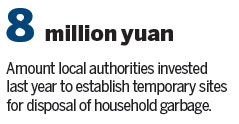Meng Fanhua believes that the greatest achievement of his life was completing a two-day walk around the base of Mount Kailash, a holy mountain in Ngari prefecture, in western Tibet, last year.
"It was exhausting physically, but I have never felt better than after that journey. It was truly the greatest adventure of my life - and the most valuable one," the 50-year-old painter from Liaoning province said of his pilgrimage.
Meng undertook the adventure last year, one of the 470,000 pilgrims who visited the mountain during the Chinese Year of the Horse.
Mount Kailash and Lake Mansarovar, also in Ngari, are sacred sites to followers of Tibetan Buddhism, the Bon religion, Hinduism and Jainism.
For pilgrims, circling either site is a great honor and the fulfillment of a lifelong desire. Tibetan Buddhists believe that features such as mountains and lakes are living entities and are born in a certain year of the animal zodiac.
If a pilgrim circles Kailash in the Year of Horse, the year the mountain is believed to have been born, it is a doubly auspicious act and equal to 12 revolutions in other years. They believe the journey will wash away the sins of one lifetime and bring prosperity.
The rising number of tourists has led the local government to implement measures to guarantee the pilgrims' safety, fulfill their religious needs and protect the environment.
Last year, the number of pilgrims soared to about 470,000, a rise of more than 50 percent from 2013, with 30,000 hailing from neighboring countries, such as Nepal and India, according to the Ngari government.
"It was so crowded. You could see pilgrims every few meters. People followed the same path, some Tibetans kowtowed, some walked," said Meng. This year he plans to fully circle Nam Co Lake, about 117 km northwest of Lhasa, the capital of Tibet, because this is the Year of the Sheep, when the lake is said to have been born.
Last year, the local government invested more than 8 million yuan ($1.25 million) to establish temporary sites for the disposal of household garbage to provide better services for travelers and to protect the environment, according to Champa Tsultrim, head of the Ngari Environmental Protection Bureau.
"We also increased the number of trashcans alongside Mount Kailash and Lake Mansarovar to guarantee one every 3 to 5 kilometers," he said.
It's illegal to dig landfills for garbage disposal in the immediate vicinity of the mountain or lake, so temporary sites are used to store the waste, which is collected every other week and then transported to Purang county, about 100 km away from the mountain and 35 km from the lake.
To ensure the environment remains unspoiled, no industrial activity is allowed in the area, Champa Tsultrim said.

Last year, the local forestry bureau established a hotline to allow local residents and visitors to report behavior that could result in pollution, such as dumping garbage or fishing in the lake, but also to alert the authorities to the plight of sick or injured animals.
If a call contributes directly to environmental protection, the caller is rewarded accordingly, the bureau said.
Several parts of the lake have been set aside for pilgrims whose beliefs require them to bathe in the waters, and wardens keep a sharp eye out for anyone using detergents or soap that could damage the ecosystem.
"We have established six monitoring stations along the lake and hired local residents to oversee environmental protection," Nyima Phuntsok, head of Ngari's forestry bureau, said.
Contact the writers through luowangshu@chinadaily.com.cn